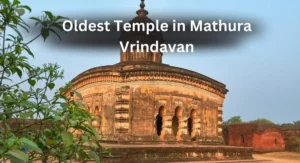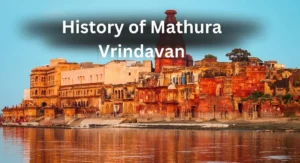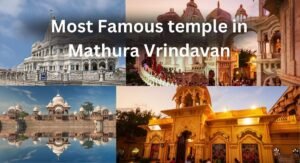If you step once into the lanes of Mathura City India, you will feel that this is not just a city, but a living chronicle moving on the pages of time. On the stones here, in the bells of temples, and in the winds along the Yamuna, everything is recorded that has touched the human heart for centuries. This is the very land where the butter-stealing plays of little Kanha have turned into folklore, and where even today every lane seems to indicate some story.
Table of Contents
ToggleWhy does the history and culture of Mathura India feel eternal?
The history and culture of Mathura India cannot be searched only in books. It breathes in the everyday life of the people here. On the walls of temples, in the songs of pilgrims, and in the voice of the simple shopkeeper, this history appears alive.
Greek travellers called it a prosperous city, Buddhist monks described its monasteries, and later dynasties decorated it with art and architecture. Then even the British noted in their records the fairs, the ghats, and the tireless stream of devotees. When you walk in this city today, it seems as if you are travelling through many eras at once.
Are the famous temples in Mathura city mere shrines?
Not at all. The famous temples in Mathura city are in fact living witnesses of history and faith. The Krishna Janmabhoomi Temple is not merely a structure, but the very axis where myth and reality meet. Seeing the splendour of the Dwarkadhish Temple, it seems as if art itself has taken the form of devotion. And when you stand at Vishram Ghat and hear the echo of the bells, you understand that worship is not only ritual, but also a dialogue between the soul and time.
In these temples, the crowd does not gather only during festivals; here every day someone comes with his personal prayer, his personal search. That is why these temples are not only structures of bricks and stones, but living centres of emotions.
What are the tourist attractions in Mathura city beyond temples?
It is true that temples are the heartbeat of this city, but tourist attractions in Mathura city are not limited only to them. The ghats of the Yamuna, especially Vishram Ghat, are like that invisible bridge which connects gods and humans, past and present. In the evening aarti, when the lamps wave and float on the water, it seems as if time itself has stopped there.
In the Mathura Museum, there is the fineness of sculpture which immortalises the memories of the Gupta and Kushan periods. And the bazaars of the lanes — where everything from brass idols to colours of abir-gulal is sold — prove that even commerce sometimes becomes the protector of tradition.
During festivals, the city itself seems to become the stage of some epic. On Holi, a flood of colours overflows, and on the night of Janmashtami, when chants resound at midnight, it feels as if the universe itself was waiting for this very moment.
Why does Mathura City India remain timeless in the modern age?
Modernity came here, but the soul did not leave. At the crossroads of Mathura City India, you will hear the noise of traffic, but at the same moment the sound of the conch shell from the nearby temple. New buildings were made, but the old steps of the ghats are still bearing the weight of the devotees’ feet. This is the strength of this city — it does not fight modernity, but absorbs it.
That is why even today Mathura is not only a tourist destination but an experience. An experience which shows that a story can cross ages, that devotion can take a new form in every generation, and that culture, when rooted in the sacred, never grows old.
Why Mathura Vrindavan Temples should be your companion here?
Because travel is not only the name of seeing places, it is the dialogue of the soul. The aim of Mathura Vrindavan Temples is only this — that we take you beyond the guidebook. We show you how in the morning aarti the sound of bells merges with the heartbeat, how the lamps floating on the Yamuna bring light not only to the water, but also to your memories.
The experience of Mathura is not one to be taken only once; it becomes your companion for a lifetime. And we try to take you towards that very experience.
FAQs on Mathura City India
1. Why is Mathura City India so famous?
Because it is known as the birthplace of Lord Krishna and as one of India’s most important cultural and spiritual centres.
2. What are the major tourist attractions in Mathura city?
Krishna Janmabhoomi Temple, Dwarkadhish Temple, Vishram Ghat, Mathura Museum, and the local bazaars are must-visits.
3. How significant is the history and culture of Mathura India?
Mathura’s history spans more than 2,500 years, carrying influences from Hindu, Buddhist, and later traditions, making it a cultural treasure.
4. Which are the most famous temples in Mathura city?
The Krishna Janmabhoomi, Dwarkadhish Temple, and Gita Mandir are among the most renowned.
5. What is the best time to travel to Mathura?
Holi and Janmashtami are unforgettable experiences, but October to March offers pleasant weather for visitors.
Plan Your Spiritual Journey Today
Have questions or need assistance organizing your visit to the sacred temples of Mathura and Vrindavan? We’re here to help you every step of the way.
Email us at info@mathuravrindavantemples.com
Call or WhatsApp us at +91-7819818361
Let the divine journey begin with Mathura Vrindavan Temples.




